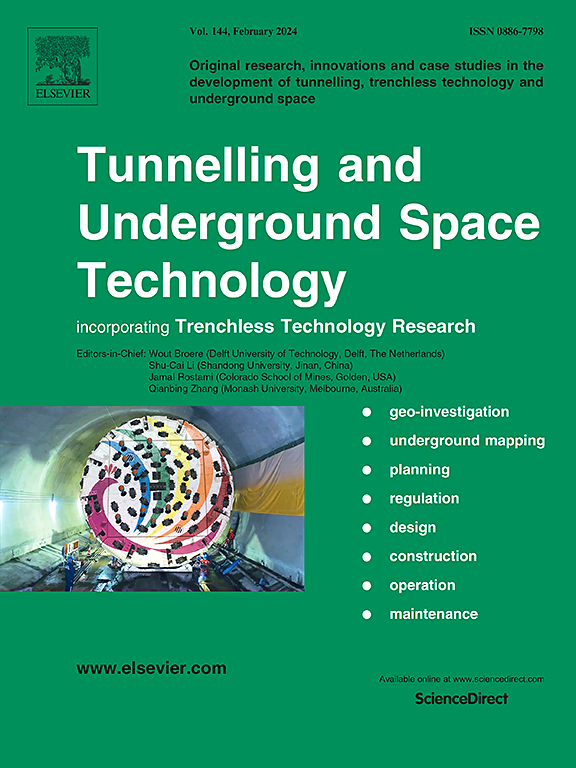Underground space in dry sand and effect of dredging on diaphragm wall using helical anchors − A model study
IF 6.7
1区 工程技术
Q1 CONSTRUCTION & BUILDING TECHNOLOGY
引用次数: 0
Abstract
Deep excavation has become inevitable for creating underground spaces due to the restricted space in urban areas. The diaphragm wall is an effective solution for restricting the lateral movement of soil and providing a sequence of stable excavation. The anchors in the backfill hold the diaphragm wall at its position and restrict its lateral movement and subsidence during excavation as well as serviceable time. The present research work has developed a scaled-down diaphragm wall with helical anchors based on past case histories of the deep excavations. Parameters such as offset distances (distance of the loading from the edge of the wall), anchor inclinations, and anchor lengths are varied. The footing offsets x/H = 0.1, 0.2, 0.3, and 0.4 (x/H is the ratio of horizontal distance between the edge of footing and wall to the height of the wall), anchor inclinations from 5° to 20° (with horizontal) and anchor lengths of 0.6H and 0.9H have been tried in model tests. Comparative analyses of anchored diaphragm wall versus unanchored diaphragm wall have been made based on the responses imparted by anchors. Thereby, an optimized design of anchors has been developed. It was observed that increasing the anchor inclination up to 15° relative to the horizontal reduced the pressure on the wall, lateral displacement, and subsidence near the wall. However, inclinations beyond 15° reduced the stability of the diaphragm wall. Additionally, the unanchored diaphragm wall experienced higher pressure than the anchored wall. The excavation depth was less when the offset distance of loading was closer to the wall due to excessive lateral pressure. The pressure on the anchored wall was reduced by 37 % when the offset distance increased from 0.1H to 0.4H. An increase in the length of the anchor from 0.6H to 0.9H caused a reduction in pressure on the wall by 31 %. The model tests suggest that anchors in the backfill at 15° inclination and length of 0.9H exhibit the highest reduction of pressure on the diaphragm wall.
干砂中的地下空间和挖掘对使用螺旋锚杆的地下连续墙的影响 - 模型研究
由于城市空间有限,深层挖掘已成为创建地下空间的必然选择。地下连续墙是限制土壤横向移动和提供稳定挖掘顺序的有效解决方案。回填土中的锚固件可将地下连续墙固定在其位置上,并限制其在挖掘期间和使用期间的横向移动和下沉。本研究工作根据以往的深层挖掘案例,开发了一种带螺旋锚杆的小型地下连续墙。偏移距离(荷载与墙体边缘的距离)、锚杆倾斜度和锚杆长度等参数均有变化。在模型试验中尝试了基脚偏移 x/H = 0.1、0.2、0.3 和 0.4(x/H 是基脚边缘与墙壁之间的水平距离与墙壁高度之比)、5° 至 20°(水平)的锚杆倾斜度以及 0.6H 和 0.9H 的锚杆长度。根据锚杆传递的响应,对锚固地下连续墙和非锚固地下连续墙进行了比较分析。由此,开发出了锚固件的优化设计。结果表明,锚杆相对于水平面的倾斜度增加到 15°时,墙体所承受的压力、侧向位移和墙体附近的沉降都会减小。然而,超过 15° 的倾斜度会降低地下连续墙的稳定性。此外,无锚固的地下连续墙比有锚固的墙承受更大的压力。由于横向压力过大,当加载偏移距离更靠近连续墙时,挖掘深度较小。当偏移距离从 0.1H 增加到 0.4H 时,锚固墙所承受的压力减少了 37%。锚固长度从 0.6H 增加到 0.9H 时,墙面压力减少了 31%。模型试验表明,倾斜度为 15°、长度为 0.9H 的回填土中的锚固件对地下连续墙的压力降低幅度最大。
本文章由计算机程序翻译,如有差异,请以英文原文为准。
求助全文
约1分钟内获得全文
求助全文
来源期刊

Tunnelling and Underground Space Technology
工程技术-工程:土木
CiteScore
11.90
自引率
18.80%
发文量
454
审稿时长
10.8 months
期刊介绍:
Tunnelling and Underground Space Technology is an international journal which publishes authoritative articles encompassing the development of innovative uses of underground space and the results of high quality research into improved, more cost-effective techniques for the planning, geo-investigation, design, construction, operation and maintenance of underground and earth-sheltered structures. The journal provides an effective vehicle for the improved worldwide exchange of information on developments in underground technology - and the experience gained from its use - and is strongly committed to publishing papers on the interdisciplinary aspects of creating, planning, and regulating underground space.
 求助内容:
求助内容: 应助结果提醒方式:
应助结果提醒方式:


